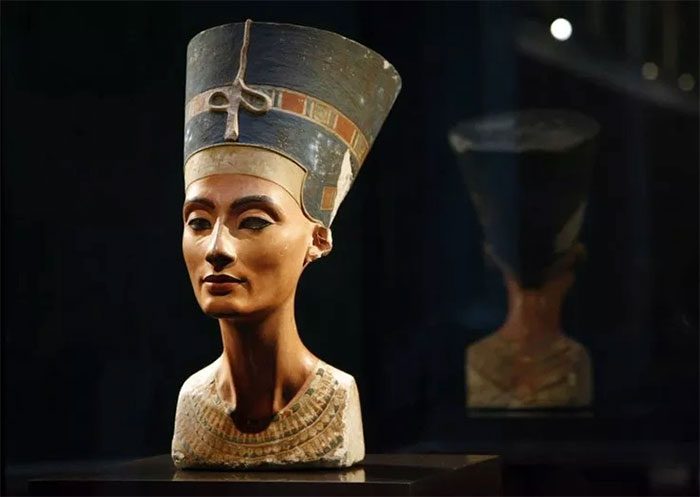Nefertiti – The Queen of Egypt, wife of Pharaoh Akhenaten, is regarded as one of the most beautiful queens of ancient Egypt. Her famous bust is currently on display in a museum in Germany.
Neferneferuaten Nefertiti was a queen of the 18th dynasty of ancient Egypt and the wife of Pharaoh Akhenaten. Nefertiti and her husband are well-known for their religious revolution, during which they worshiped a single god, Aten. The reign of Pharaoh Akhenaten is considered one of the wealthiest periods in ancient Egyptian history. Some scholars believe that Nefertiti ruled briefly under the name Neferneferuaten after her husband’s death, a topic that remains debated. If Nefertiti did rule as Pharaoh, her reign would have been marked by the collapse of Amarna and the relocation of the capital back to Thebes, Egypt.
Nefertiti is very famous due to her bust, which is displayed at the Neues Museum in Berlin, Germany. The bust of Queen Nefertiti is considered one of the most famous artworks of ancient Egypt, a quintessential example of ancient art, and thanks to this statue, Nefertiti has been referred to as the most beautiful woman in the world. The statue has “mesmerized” everyone since its unveiling in 1923. It provides insight into the mysterious queen and continues to provoke debate and discussion in art and politics.

Bust of Queen Nefertiti. (Photo: Reuters).
The bust of Queen Nefertiti stands about 48 cm tall and weighs 20 kg. The statue is very delicate, elegant, and highly symmetrical. It was sculpted around 1340 BC during the Amarna period and is believed to be the work of the sculptor Thutmose, as it was found in his workshop. The statue is identified as Nefertiti by her distinctive blue crown adorned with a cobra. The core of the statue is limestone covered in plaster.
Archaeologists do not have much information about Nefertiti, a name meaning “the beautiful one has come.” One hypothesis suggests she was a Syrian princess, and her husband, Pharaoh Akhenaten, is famous for overhauling Egyptian religion – shifting it from polytheism to monotheism centered around the sun god Aten. He also moved Egypt’s capital from Thebes to a new site at Amarna. Nefertiti is believed to have married at the age of 15, before Akhenaten ascended the throne. She had six daughters, and in artworks, Nefertiti is depicted on par with the king, akin to a co-regent, contrasting with the traditional role of queens.
The bust of Nefertiti was discovered on December 6, 1912, at Amarna, a vast archaeological site in Egypt, by a German team led by archaeologist Ludwig Borchardt. It was found in the workshop of sculptor Thutmose along with other unfinished busts of Nefertiti.
What makes this artwork unique is that the statue appears not to have been intended for a tomb – unlike many other Egyptian artworks. It is a model, a prototype statue to be used for other artworks. Egyptian sculptors rarely attempted to express any emotion on the faces in their art, but the face of this statue embodies serenity and calmness. Aside from a damaged left eye and ear, the statue was discovered in excellent condition.
When the bust was first found, the left eye was missing the quartz stone representing the iris, unlike the other eye. Despite thorough searches, archaeologists could not find the left iris of the statue. The missing eye led to speculation that Nefertiti may have suffered from an eye infection and lost her left eye. However, the presence of full irises in other statues of her contradicts this possibility.
The Nefertiti bust has been in Germany since 1913 and was displayed at the residence of Simon, a businessman and sponsor of the Amarna excavation. The statue was donated to the Egyptian Museum in Berlin in 1920. In 1923, the statue was introduced to the public as a significant piece of the Egyptian Museum in Berlin, Germany. The exquisite statue quickly became a world-famous symbol of feminine beauty and one of the most notable artifacts surviving from ancient Egypt. Hitler once described the bust as a unique masterpiece, a decorative object, a true treasure, and committed to building a museum to house it.
The statue returned to the Neues Museum in Germany when it reopened in October 2009, and for many years, Egyptian authorities have consistently requested Germany to return this beautiful bust to Egypt.
The mystery surrounding the Nefertiti bust is one of the reasons that Nefertiti’s life remains fascinating and captivating. This statue has been admired, studied, and replicated extensively. Ongoing debates about Nefertiti illustrate her enduring status as a highly regarded historical figure and how art plays a crucial role in fostering these discussions.


















































